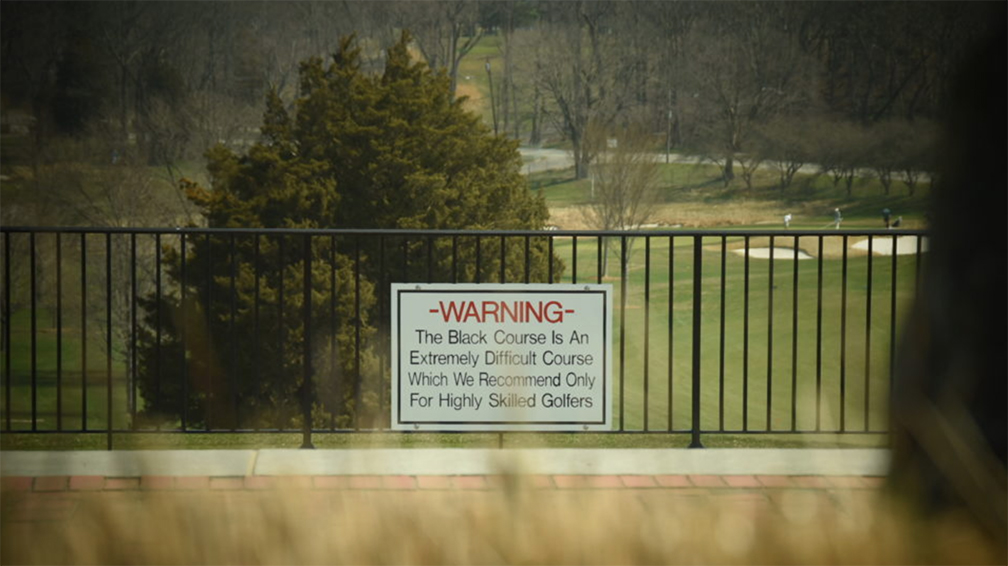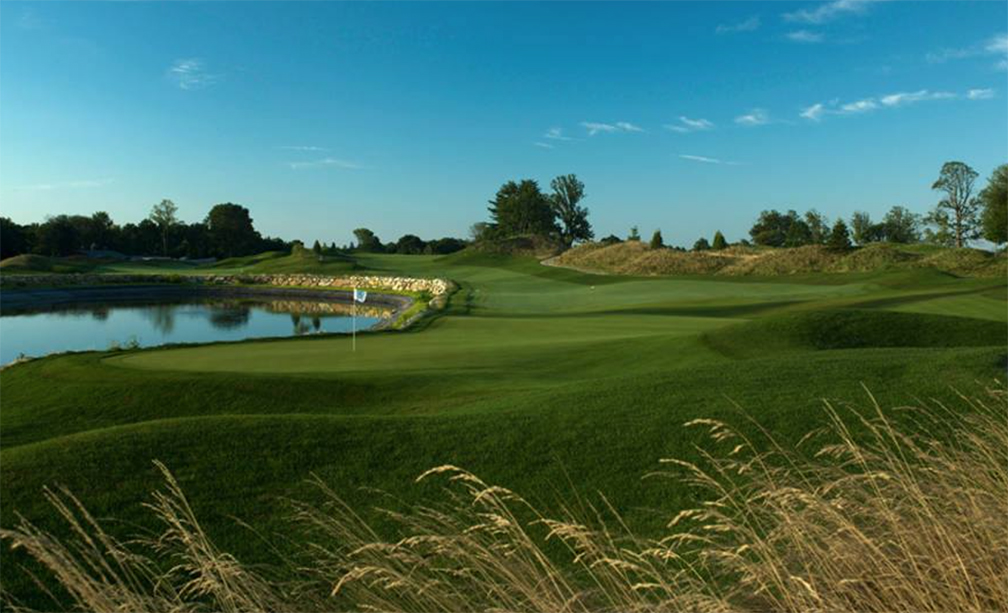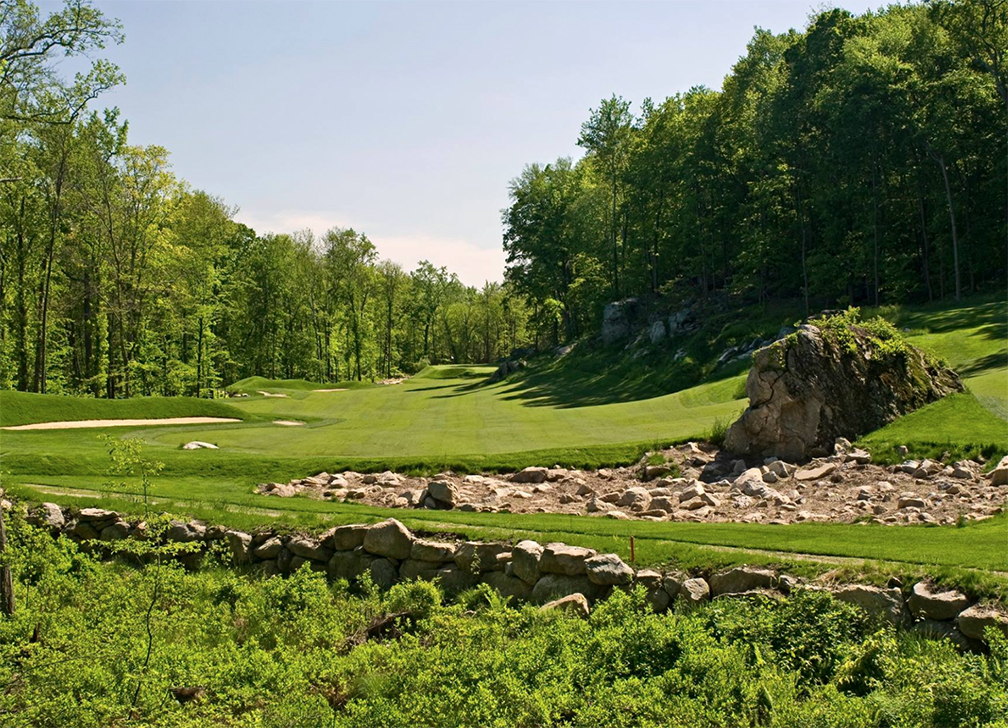
The first thing that comes to mind when thinking about golf near New York City is likely one of the seemingly endless supply of high-profile private clubs in the area – headed by Shinnecock Hills and the National Golf Links of America in Southampton, or the two courses at Winged Foot Golf Club in Mamaronek, or Liberty National Golf Club across the Hudson River in Jersey City.
Each of these courses has enjoyed plenty of television time as hosts of prestigious PGA Tour events, but access to play is limited to members and guests, not the common Joes, even ones with deep pockets.
But don’t fret, there are plenty of wonderful public courses in the New York City region and out on Long Island, tracks that run the gamut from the famous, to the opulent, and to the friendly.
On a recent trip to the Big Apple and up the (considerable) length of Long Island, we played three courses that we highly recommend – the famous Black Course at the Bethpage State Park, the over-the-top pristine and memorable Pound Ridge Golf Club about an hour north of Manhattan; and the Red course at Eisenhower Park in nearby Nassau County.

Pound Ridge Golf Course
Always bet on (Bethpage) Black
The Black Course at Bethpage on Long Island might be the one public course in the New York area even casual golfers are familiar with because it hosted the U.S. Open in 2002 and 2009 and the PGA Championship in 2019.
Let’s get the obvious out of the way at the start: the Black, famously one of the most penal tracks ever built, is not for the faint of heart or those golfers without absolute conviction and confidence in their game.
But it’s all worth it. Beginning at the clubhouse where you can get a mean egg sandwich, or a full breakfast before the round or a steak afterwards and ending in the golf shop where you can spend a half-hour after the round buying a shirt or a driver cover or a ball marker or a cap with the iconic Bethpage logo. This place is all about golf, and the pleasures and tests of the game.
The round at the Black, which was an A.W. Tillinghast-design restored and revamped by Rees Jones, proved to be an experience that met all our expectations, exceeded most, and affirmed the reasons why the course must be on the list of every serious golfer’s must-play experiences.
We opted to play the white tees at the Black, which are carded at 6,684 yards for the par-71 but play at least 200 yards more because of the penal greens. The back tees themselves play at 7,468 yards, but if you’re really up for that test you have a lot more golf game than 99 percent of us that play golf regularly.
The first thing you notice as you walk around the clubhouse to the first tee is a sense of grandeur here – everything feels big, difficult, and larger than life.
The first hole, a 429-yard par-4, is right in your face. You can see the fairway as well as the green around the sharp dogleg, but to get around the corner you really need to bomb it or the trees on your right are going to give you some trouble. The putting surface, as with most on the Black, is relatively flat, but staggeringly fast. But it’s on the greens or you can make up strokes.
After a walk through the tunnel and up the hill, the second hole a 354-yard par 4 that plays uphill, with the approach also uphill and over a huge bunker. The third, a 158-yard par 3, has a huge, crowned putting surface and plenty of danger at the rear, making club selection and accuracy paramount.
The par-5 fourth is one of the signature holes at the Black and is every bit as difficult as it’s feted to be despite playing only 461 yards from the white tees. The drive must be either short of or over a string of bunkers at the middle of the fairway. While some golfers might try to go for the uphill green in two strokes the prudent play is short and right, leaving a 70-yard shot to the putting surface which moves from front to back.
The 502-yard par-5 seventh moves left to right off the tee and was played at a 489-yard par-4 in the 2009 U.S. Open. For the average player it represents one of the few chances for birdie. Another birdie chance awaits at 191-yard par-3 eighth, the only hole on the Black that forces the golfer to carry a water hazard. You have to attack the hole from the left side and get your shot all the way to the hole location – anything short of or on the front part of the green risks the chance of rolling back into the pond.
There is no return to the clubhouse after the front nine. Beginning with the 434-yard 10th, the back nine features a series of increasingly difficult par-4s, all of them playing uphill to raised greens. The 11th goes at 421 and the 12th is carded at 432 yards. Both of them are lined with fairways with four-inch-thick rough.
You get a break from the arduous two-shotters with the 480-yard, par- 5 13th, which sounds short but believe us plays long, and the 152-yard par-3 14th, on which you want to be anywhere but the huge bunker that fronts the putting surface.
Back through the tunnel is the 15th, which may be the hardest par-4 you’ll ever play and is the course’s No. 1 handicap. At 430 yards, it’s a sweeping dogleg left that gives you a pretty open tee shot but has one of the most difficult approaches on the course. Playing to the green is like hitting a shot to the top of a four-story building surrounded by sand – it’s really that severe and daunting.
Then comes the Black’s iconic par-3, the 195-yard 17th. Here the putting surface is hidden by deep bunkers on all sides, making the golfer hit a high, soft shot into a shallow, tiered, lightning-quick green.
The closing hole is another iconic offering, a 395-yard par-4 that plays through deep bunkers on both sides of the landing area and up to the elevated green in the shadow with a massive clubhouse.
If you get a chance to play at Bethpage Black, jump at the opportunity and savor the test – just remember that almost everyone who’s played the course has walked away humbled, but happy.

Bethpage Black
Pound Ridge is Dye-abolical and fun
Even after all the things we’d heard about the Pete and Perry Dye-designed Pound Ridge Golf Club in the northern suburbs of New York City, we still weren’t sure what we would experience once we set foot on the gorgeous, rolling site.
One thing’s for sure – you better put your big-boy pants on if you expect to have any semblance of success here.
Pound Ridge, located about 15 minutes from Stamford, Conn., is an 18-hole daily-fee venue that plays as a par-72 and measures 7,171 yards from the tips. Developed by the Wang family, the 172-acre course was legendary Pete Dye’s first design in the Empire State.
Carved out of as much as 14,000 feet of rock walls, outcroppings and house-size boulders, the fairways are interspersed with trees, streams, wetlands, and water hazards as the layout snakes its way to the tops of ridges, through hardwood forest and open, rolling meadows.
The site features more than three miles of stone walls that run through the property and the knock-your-socks-off hazard called “Pete’s Rock,” a massive boulder that blocks the view of the fairway from the 13th tee, a 486-yard par-5. Dye was quoted as saying that the Pound Ridge site is “as difficult a piece of property to build a golf course on as I’ve ever seen.”
If it was hard to build, it’s even tougher to play. Like a huge intricate puzzle, the elements at Pound Ridge blend but are never transparent in the course’s plentiful package.
“The rocks here actually have become an asset, and you could not afford to do what we’re doing here today if we had to go buy the rock,” Pete Dye said. “The things that made it hard to build make it beautiful.”
Added to the rocks are trees and blind shots over mounds to well-protected and often elevated greens complexes.
Most of all you have to be accurate at Pound Ridge. That task is mitigated somewhat by the course’s five sets of tees, which are classified by handicap ability, allowing players of all skills to enjoy the strategic layout and wide variety of shot-making options.
There are plenty of holes at Pound Ridge – mostly those that are in the meadow (most of the front nine and Nos. 16-18) – where you think you can bust the driver and attack the course. But, as usual with Dye layouts, even the holes where you think you might grab the upper hand can rein you in.
Perhaps the best stretch is the trio at Nos. 13-15. On the 485-yard, par-5 13th, the drive is over “Pete’s Rock” to a saddle-shaped landing area with danger on both sides. The tiny green is guarded left by a deep ravine with a bunker in its deep floor, and along the right by woods. Take some personal advice: play this as a three-shotter and hope to make the par putt.
The 429-yard, par-4 No. 14 requires a long carry across a deep and elevated chasm fronted by a stone wall. Once across, the hole bends left and plays uphill to a semi-blind green set between two hummocks. Avoid the rock outcroppings that line the left side of the fairway.
You’ll be amazed at what awaits at the short and quirky par-3 15th, with its backdrop of a large white-rock outcropping. The hole is played entirely over wetlands fronting the green that obscure much of the diagonal putting surface from the tee. Once across, you’ll see that the green is actually quite roomy, and even if you play your shot off the rock, it has a chance of finding the putting surface (just don’t bet on it).
The three closing holes – the uphill 564-yard par-5 16th and two testy par-4s in the 457-yard 17th and the 454-yard 18th (where your drive must be played over a stand of trees) – will make you take a deep breath. Success on this threesome will hinge on the state of your nerves and a great short game.
The property features some of the highest points in Westchester County, with a number of tees offering expansive vistas of the surrounding countryside.

Pound Ridge
Red Course at Eisenhower Park has stood the test of time
The Red Course, one of three 18-hole golf courses at Eisenhower Park just on the other side of Queens, was originally part of the exclusive Salisbury Golf Club, begun by wealthy Long Islanders.
During the heady 1920s, the Salisbury Club was a centerpiece in the social life of wealthy families along the North Shore. The Red course played host to the 1926 Professional Golfers’ Association of America (PGA) Championship, won by the legendary Walter Hagen for a purse of $11,100.
During the Depression, Nassau County took over the Salisbury Club when the owners were unable to pay the property taxes. The Red was the only original Salisbury course to survive the club’s downturn and World War II and was later joined by the new White and Blue Courses in the 1950s. In 1944, the county established its first major public park on the site and rededicated the property as Eisenhower Park in 1969.
The Red course was designed in 1914 by Devereux Emmet, one of the most prominent of the architects of the Golden Age. The par-72 track measures 7,107 yards from the championship tees and the PGA Tour Champions Tour made the lengthened and modified Red a popular stop in recent years for the Commerce Bank Championship.
Eisenhower Red’s setup is quite direct – you can hit strong drives that consistently give you the opportunity to attack the flag from the Red’s generous fairways or you can struggle off the tee and play defensive golf, fighting poor angles on doglegs and navigating around a plethora of strategic bunkers and shot-blocking evergreens.
The Red’s large greens roll at medium speed and include very subtle breaks and turns. Stay below the hole on Nos. 10 and 12, both of which feature tricky ridges.
The Red’s par-3s are fun tests of accuracy that, if failed, then become trying tests of sand skills. The longest one-shotter, the 211-yard 13th, plays to a slightly elevated green; aggressive shots to a right-side pin must carry a hefty bunker.
Just as it begins, the Red closes with the challenge of distance. The par-5 17th is the longest hole on the course and the only one to crack 500 yards from the whites. The round concludes with a 455-yard par-4 that tees off to a rising fairway. Players that send their drives offline stand little chance of recovering well enough to make par.
Eisenhower Park is a breath of fresh air in the heart of Nassau County, and the Eisenhower Red course offers as serene a setting as one can find in such a bustling location. It’s a fun track whose test is in its simplicity and requires good golf from the first tee to the 18th green.

